Meeting of the Board of Regents | November 2008
|
|
THE STATE EDUCATION DEPARTMENT / THE UNIVERSITY OF THE STATE OF NEW YORK / ALBANY, NY 12234 |
|
TO: |
|
|
FROM: |
Johanna Duncan-Poitier |
|
SUBJECT: |
Regents 2009-10 Conceptual Proposal on State Aid to School Districts |
|
DATE: |
November 24, 2008 |
|
STRATEGIC GOAL: |
1, 2, 3 and 5
|
|
AUTHORIZATION(S): |
|
SUMMARY
Issue for Decision
Does the conceptual proposal reflect the Regents goals and funding priorities for pre-kindergarten through grade 12 education? Are the right program directions emphasized in the Regents State Aid proposal?
Reason(s) for Consideration
Policy action.
Proposed Handling
These questions will come before the Subcommittee and Full Board at your November meeting for discussion and action.
Procedural History
The Regents Subcommittee on State Aid began its discussion about the development of the Regents 2009-10 State Aid proposal at its May 2008 meeting. Subcommittee members discussed recommendations included in the reports issued by the New York State Commission on Local Government Efficiency and Competitiveness and the New York State Commission on Property Tax Relief in July. In September, the Subcommittee discussed foundation aid and in October, a report on BOCES and feedback from the Education Finance Advisory Group.
Background Information
In seeking to close the student achievement gap, the Regents recognize that funding is one key component of a solution. The Regents proposal seeks to achieve equity, adequacy, accountability and balance between stable and targeted funding. New data on high school completions shows the achievement gap remains an urgent need. New methods of linking funding to results make the goals of this proposal more possible than ever.
Recommendation
I recommend that the Subcommittee recommend approval of their conceptual State Aid proposal for 2009-10 to the Full Board and that the Full Board take the following action:
VOTED, that the Board of Regents approve its proposal on State Aid to school districts for school year 2009-10 as described in the attached pages.
Timetable for Implementation
Following the Regents approval of the final State Aid proposal for 2009-10, the Governor will issue his budget recommendations in December and has asked the Legislature to approve a State budget before April 1.
Attachment
Conceptual Proposal
The Regents State Aid proposal for school year 2009-10 details critical funding recommendations to provide an adequate basic education to the State’s children. It also includes recommendations to reduce spending through mandate relief, shared services and changes in special education. The pupil needs this proposal is designed to address remain pressing and are likely to grow even more dire as a result of the troubled economic times we are facing. Therefore, the Regents assert that the State must continue to support the work begun and progress made in prior years. This proposal recommends preserving the foundation formula advocated by the Regents and enacted in the past two State budgets.
Four principles continue to guide this Regents proposal. During difficult economic times adhering to these principles is even more important.
Adequacy—Distribution of funding across all districts according to the Foundation Formula will move us closer to ensuring adequate resources for higher levels of student achievement.
Fairness—The funding system must be fair for students and taxpayers. State resources should be allocated on the basis of fiscal capacity, cost and student needs. The emphasis is providing a set of inputs to adequately educate students regardless of where they attend school.
Accountability—The education system will measure outcomes and use those measures to ensure that financial resources are used effectively. The Regents will employ a two-pronged strategy to ensure education resources will be used or maintained in the public interest. The Department will give greater flexibility to districts with acceptable student achievement, while working closely with districts not yet meeting State standards.
Balance—The State should balance stability in funding with targeting aid to close student achievement gaps. It should drive aid based on current needs, while establishing reasonable amounts of hold-harmless aid to provide stability.
This proposal pursues three Regents goals: to close the gap between actual and desired student achievement; to ensure that public education resources are adequate; and that school districts use these resources effectively and efficiently. At the September 2008 board meeting, the Regents highlighted numerous examples of improvement in student achievement since 1996 when the Regents began to raise standards for all grade levels and imposed graduation requirements aligned with these new standards. The data show that student success is growing and reforms are working. Despite this, challenges remain and we must continue to seek adequate funding for all of our school districts.
Student Success is Growing
Improvement in educational outcomes for students can be found throughout the educational system. For example, student achievement improved in fourth grade English language arts from 1999 to 2008 by up to 30 percent. All five of the racial/ethnic categories in Figure 1 experienced significant improvement in the percentage of 4th grade pupils scoring at least proficient (i.e., equal to a Level ‘3’ or ’4’) on the English Language Arts (ELA) assessments from 1999 to 2008.
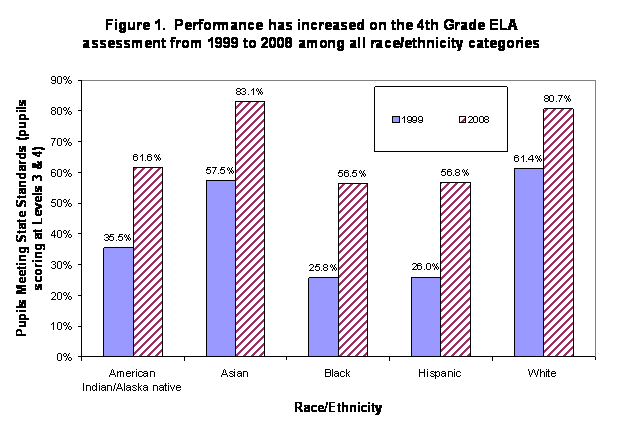
The academic improvement experienced by Hispanic and Black students was the greatest.
Figure 2 shows that even greater gains in proficiency over the same time period were experienced by Black and Hispanic 4th graders on the Math assessment.
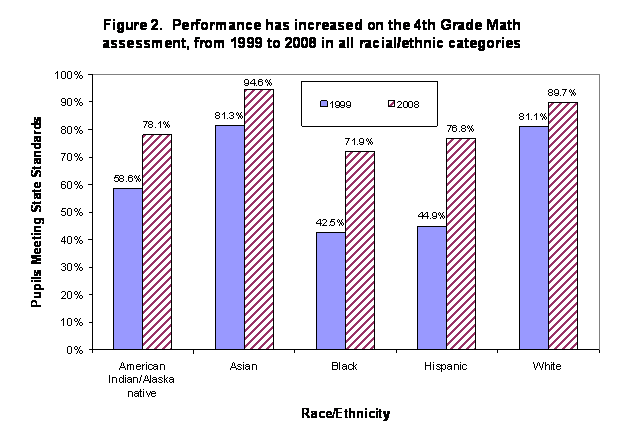
Figure 3 shows that Black and Hispanic students have experienced similar improvement on the 8th grade Math assessment: both student categories had gains of almost 40 points in the share of pupils scoring at least proficient.
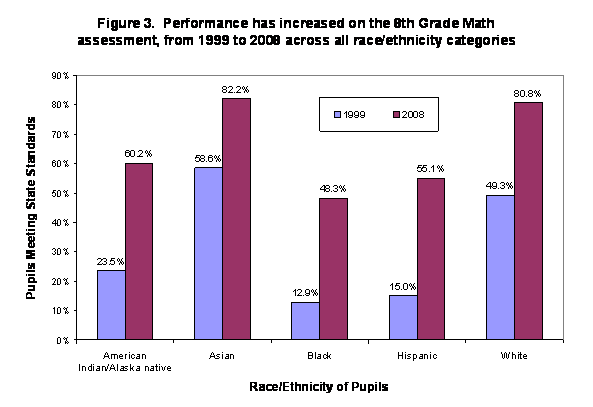
Challenges Remain
Despite these large improvement gains over the last nine years, significant achievement gaps do remain. In each of the three prior charts the achievement gap between Black/Hispanic and White pupils was on average more than 20 percentage points.
Moreover, the improvement of Black and Hispanic students exhibited in the previous three charts is largely absent in Figure 4, relating to the performance on the 8th grade ELA exam. For these pupils, by 2008, only about a third of pupils are attaining at least proficiency, while more than two-thirds of White and Asian students are doing so.
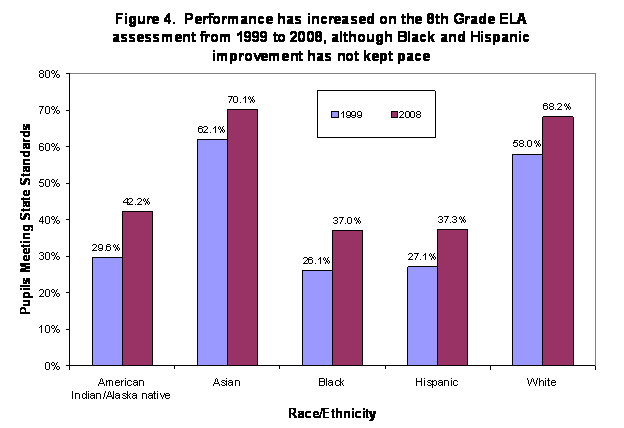
Figure 5 shows the percent of students that graduated with a Regents diploma in groups of school districts ranked by need resource capacity category (see the line) and the percent of student poverty (the bars). A general finding of this chart is the well established relationship between pupil poverty and achievement that the Regents proposal seeks to address: districts with greater populations of poor students are generally graduating with Regents diplomas at lower rates.
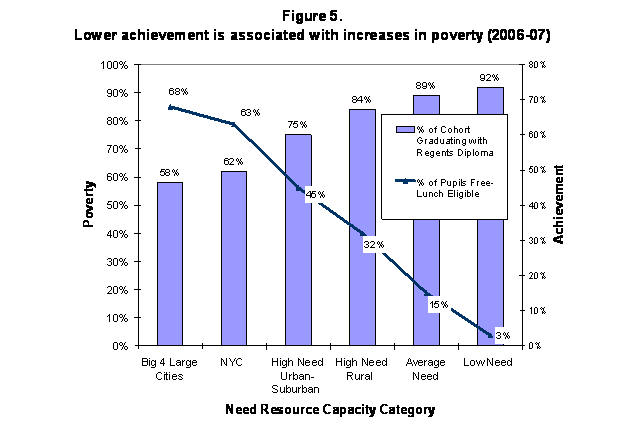
One of the strongest achievement effects in educational research is for teacher quality. It is useful to examine the variation in teacher quality measures which may explain some of the variation in graduation rates by need-resource capacity, shown in Figure 5. Figure 6 shows that the Big 4 Cities, who in Figure 5 had the lowest rate of Regents diploma graduation attainment, do have significantly less qualified teachers, as measured by credentials, than the rest of the State’s school districts.
Finally, Figure 7 examines school district expenditures per pupil for school year 2006-07 by Need-Resource groupings of school districts. In this chart, the pupil count has been adjusted to reflect the additional cost of educating children from poverty backgrounds . This chart shows that when one adjusts for student needs, the spending of low-need, greater wealth districts is markedly greater than it is for both high need and average need districts. On average, low need districts expend roughly 40 percent more per pupil than do these other groups of districts.
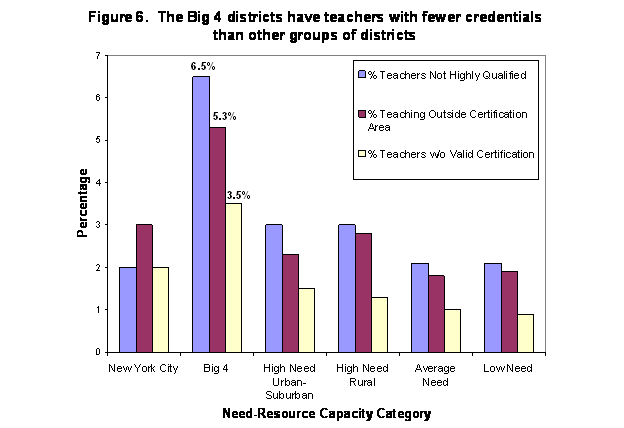
After two years of the foundation formula, New York State is well on the way to ensuring adequate funding so that all students can succeed. Continued implementation of this reform is necessary and important for further success.
At a recent Governor’s summit on student engagement and dropout prevention, Commissioner Mills reported that “25,000 students who entered ninth grade in 2003 dropped out. Even in good times, uneducated young people are marginalized.” He asked: “Imagine what those 25,000 young men and women are doing today?”
He summarized the story by reporting that:
- Graduation rates for black and Hispanic males have improved, but are still unacceptably low;
- Graduation rates for students with disabilities are low, particularly in high need school districts; and
- English Language Learners’ graduation rates have actually declined.
This Regents proposal will outline those actions that will continue to accelerate student learning while reducing spending.
Maintain the Commitment
The progress made by all students and especially Black and Hispanic students and by students with disabilities shows us that reforms in education are working. But the promise of a quality education depends on resources that support student learning. The State has made an historic commitment to providing adequate funding in its four-year phase in of the foundation formula begun in 2007. The State must maintain this commitment. This proposal sets forth Regents recommendations for funding New York State school districts in school year 2009-10 and beyond.
New York State made a historic commitment in 2007 to phase in a needs-based, education-oriented school funding formula. Over the past two years, the State has completed approximately 38 percent of this phase in. At the end of the phase in, school funding would be adequate, transparent and predictable. It is important to note that many districts still do not yet have adequate funding. The economic crisis may slow down the achievement of this goal, however, our state’s future depend on adequate funding.
While the State and nation struggle to adjust to an economic crisis, difficult decisions must be made about our future. Central to this, is the decision to continue to make progress toward adequate funding for our schools. This approach is based on the premise that all districts should have a minimum level of funding and although we have made significant progress, New York State has not yet achieved this funding standard. Not only does the State Constitution require adequate funding for schools, but our future economic security depends on it. Investing in the quality education children need to be successful will pay off for years to come as they pursue higher education, contribute to the workplace and contribute as citizens.
Recognize changes in district needs. While the Regents recognize the extraordinary conditions that led to the current fiscal crisis, any solution that treats all districts the same will not maintain the drive toward adequacy. The State should continue to recognize demographic and socioeconomic changes in school districts and continue to use school aid, even with limited increases or cuts, in ways that help districts equalize educational opportunity. This is especially important for districts that have limited ability to raise revenues locally and high student need and which may be highly dependent on State Aid.
This proposal recommends continuation of the phase-in of the Foundation Formula which the State began in 2007. The enacted budget for 2007-08 reformed the State’s method of allocating resources to school districts by consolidating some 30 existing funding streams into a new Foundation Aid formula that distributes funds to school districts based on the cost of providing an adequate education, adjusted to reflect regional costs and concentrations of pupils who need extra time and help to be successful. The Regents recommend maintaining the commitment to high need school districts even if this means extending the phase in of the formula.
The Foundation Formula is transparent, lending itself to public understanding and debate. It is represented by a simple formula with four moving parts:
District Foundation Aid per Pupil = [Foundation Cost X Pupil Need Index X Regional Cost Index] – Expected Local Contribution.
- The Foundation Cost is the cost of providing general education services. It is measured by determining instructional costs of districts that are performing well.
- The Pupil Needs Index recognizes the added costs of providing extra time and help for poor and needy students to succeed.
- The Regional Cost Index recognizes regional variations in purchasing power around the State, based on wages of non-school professionals.
- The Expected Local Contribution is an amount districts are expected to spend as their fair share of the total cost of general education.
Maintain existing Contracts for Excellence. The State created Contracts for Excellence in 2007 that designate how districts spend additional education aid for programs that have a track record of improving student achievement, and to document student achievement growth associated with these expenditures. The State required districts with large aid increases and low student achievement to participate in the program. It specified the amount of funding that should be directed to expand learning opportunities for students and that which could be used to continue existing district programs. The Regents recommend that the State:
- Continue to give priority in funding to high need school districts until they have adequate funding.
- Continue the link in Contracts for Excellence (C4E) between money and accountability and better align the program with the accountability system.
- Do not require districts that make adequate yearly progress to file a Contract. Department staff is continuing to review which districts should participate in Contracts for Excellence.
- Make contract requirements commensurate with the size of the achievement problem.
- If current C4E districts are ineligible in 2009-10 under current law because of the smaller size of their increase in foundation aid, the State should revise the law to require them to continue in C4E and focus on maintaining C4E programs funded in the base year without expansion of new programs. In order to protect the State’s and districts investment in C4E programs, the State should provide a short-term School Funding Adequacy and Accountability Grant to provide C4E districts with resources to help maintain their C4E programs. These grants would help districts respond to inflationary pressures and meet State accountability requirements.
- Suspend the requirement for non-C4E districts to complete district improvement plans.
- Use student achievement results to refine Contract plans.
The State has made steady progress in the implementation of universal pre-kindergarten for four year olds, with funding for 2008-09 at an estimated $451 million statewide. Funding for pre-kindergarten programs together with adequate funding for K-12 programs provided by Foundation Aid, gives districts a solid foundation with which to close the achievement gap. Research has documented the lasting impact of quality early childhood programs followed by well planned and funded early grade programs in schools. Achievement results improve, the need for special education and academic intervention declines, graduation rates increase, workforce earnings increase and crime decreases. Quality early childhood education makes good education sense and makes good economic sense.
The Regents recommend that funding for early childhood education should continue to be provided as a single funding stream, separate from but aligned with funding for kindergarten through grade 12. Funding for pre-kindergarten through grade 12 should provide school districts with the resources needed to give all students the opportunity to meet State learning standards. Funding for pre-kindergarten education should be increased to ensure universal availability of pre-kindergarten education to all by 2010‑11. The Regents recommend the State continue the phase-in proposed in the State’s financial plan, by increasing funding by $89 million over 2008-09.
Strengthen the Role of BOCES in Shared Services
Make improvements to BOCES Aid. The Regents recommend improvements to BOCES Aid by raising the cap on salaries of BOCES employees that are aidable and increase the equalization of the BOCES Aid formula by eliminating the aid ratio option that benefits wealthier school districts. This would provide additional aid for increased costs that BOCES incur for employee salaries and would enhance the State’s role of providing educational opportunity by equalizing aid so that poorer districts receive more aid and wealthier districts receive less.
Give the Big Four City School Districts access to BOCES services. The Regents recommend that the existing practice of excluding large city school districts from accessing BOCES services be discontinued. They recommends that the Big Four city school districts (Yonkers, Rochester, Syracuse and Buffalo) be given the authority to contract with a neighboring BOCES for services in critical service areas where BOCES’ expertise is strong and the city’s is weak or non-existent.
A program should be established authorizing the Big Four city school districts to participate in BOCES and purchase services from them. A corresponding increase in aid should be provided to the New York City school district to allow it to fund similar programs within the city district without BOCES. Such regional services can include:
- Arts and cultural programs for students;
- Career and technical programs for students;
- Staff development as part of a district-required professional development plan and annual professional performance review;
- Technology services provided through BOCES; and
- Regional teacher certification.
Eliminate the salary cap on district superintendents. The Regents recommend enhancing the ability of BOCES and the State to attract and retain qualified individuals to serve as District Superintendents of schools by eliminating the current cap on salaries and certain benefits while maintaining limitations on payments for accrued leave at the time of retirement or other separation from service. The Regents recommend eliminating the salary cap, currently 98 percent of the salary earned by the Commissioner of Education for fiscal year 2003-04 or $166,762, with annual increases also limited.
Encourage regional school transportation services. To reduce the cost of transporting non-public school students and students with disabilities within a BOCES region, school districts could jointly provide transportation for students crossing district lines or with similar needs. In addition, BOCES could offer transportation administration services to school districts on a regional basis as a shared service to increase the efficiency of routing and reduce the cost of administration. This shared service would generate Transportation Aid for participating school districts. The State should facilitate a demonstration project or projects to determine the effectiveness of this approach and whether it should be encouraged for statewide use. The CO-SER Committee of District Superintendents and Department staff should continue to develop this option, identifying any legislative changes needed.
Central business office demonstration. To encourage the use of BOCES for back-office school district operations like payroll and purchasing, the State should facilitate a demonstration project that will serve as a model for school districts in other BOCES regions. The CO-SER Committee of District Superintendents and Department staff should continue to develop this option, identifying any legislative changes needed.
Regional financial planning services. Promote BOCES as a resource to assist districts in developing long-term financial plans including for example, the costs of contract settlements and future liabilities for retiree health benefits, where such competence exists. Such assistance can aid districts in collective bargaining agreements, among other operations. The CO-SER Committee of District Superintendents and Department staff should continue to develop this option, identifying any legislative changes needed.
Provide greater sharing through BOCES than they currently provide. BOCES are primarily limited to providing shared services related to education for two or more school districts. This recommendation is suggested by way of testimony presented to the Local Government Commission and is not a formal recommendation of the Commission. The suggestion is that BOCES could share with municipalities other than school districts, provided that this sharing did not detract from BOCES educational mission. For example, BOCES might provide services or products to public libraries and/or municipalities such as:
- Broadband width;
- Assisting with implementing energy efficient buildings;
- Sharing transportation and maintenance; and
- Processing payroll or purchasing.
The trade-off is that although greater cost savings may be generated through scale economies, State Education Aid may actually remain the same or grow as districts claim BOCES aid on new cooperative services. A committee of Department staff and BOCES District Superintendents is examining the parameters under which BOCES services should be expanded.
Establish a BOCES statewide energy purchasing program to save energy costs. The Regents support the recommendation of the Executive Commission on Local Government Efficiency and Competitiveness to encourage the expansion or replication of the New York State Energy Municipal Cooperative of the Onondaga-Cortland-Madison BOCES to help school districts reduce their energy costs. This cooperative is a corporation established under Article 5G of General Municipal Law to coordinate the purchase of natural gas and electricity for local governments in the regions served by National Grid and the New York State Electric and Gas.
Reduce Costs through Mandate Relief
Mandate relief can reduce the costs of education services while maintaining the commitment to improving student results. The Regents recommend three directions for reducing costs through mandate relief: streamlining school district planning and reporting; enacting a simplified cost allowance for State Building Aid and making aid reforms for future projects; and reducing unnecessary interest payments for school district short-term borrowing.
Streamline school district planning and reporting. The Regents have recommended a mandate relief bill for school districts that would eliminate duplicative reporting and give the Commissioner authority to further streamline school district and BOCES planning and reporting. Streamlining will also help the Department, BOCES and district staff to use information more strategically and comprehensively and also focuses Departmental staff resources on its core operational missions and responsibilities. The bill requires the Department to conduct a review of Commissioner’s regulations within a year and eliminate duplicative or unnecessary reporting requirements for school districts that are contained in regulation.
Simplify State Building Aid and make reforms going forward. The Regents recommend that the Governor and Legislature simplify the maximum cost allowance formula for State BuildingAid. The law sets a reasonable cost ceiling for all capital projects. However, the current system is an overly complex and inefficient process that, in some cases, forces a district to compromise the desired educational goal in order to achieve maximum reimbursement. The Regents propose that the State calculate a cost allowance based on a certain allotment of space and cost per enrolled pupil, according to the following formula:
Cost Allowance = Projected Pupil Enrollment x Allowed Square Feet
Per Pupil x Allowed Cost per Square Foot x Regional Cost Factor
The current New York State Labor Department Cost Index would be used to update allowable costs on a monthly basis. Unlike the Regents Regional Cost Index enacted for Foundation Aid, which is fundamentally a professional wage index, the New York State Labor Department cost index is based solely on the wages of three major occupational titles critical to the building industry. A simplified cost allowance would offer greater educational flexibility, ease of understanding and transparency.
The Regents also recommend that staff explore options for reforming Building Aid in the future to promote efficiency and effectiveness of investment in school district capital assets.
Reduce unnecessary interest payments for school district short-term borrowing. School districts around the State issue tax warrants in August and collect tax levy in September to coincide with the start of school. Only Suffolk County sends its tax bills in December. This results in the need for extensive short-term borrowing by school districts in the form of tax anticipation notes.
Although Tax anticipation notes are usually short-term notes, the interest paid can be substantial if the amount borrowed is large. The practice of issuing these notes occurs throughout the State, but is particularly noteworthy in Suffolk County; in 2006-07, districts in Suffolk issued $870 million in tax anticipation notes, approaching 60 percent of the statewide total of about $1.4 billion. This borrowing in Suffolk has been common practice and may be caused by property tax bills going out in December, instead of September as in other counties. Fifty-six of the 65 districts in Suffolk issued Tax anticipation notes in each of the last three years. The interest paid by Suffolk districts on Tax anticipation notes exceeded $32 million in 2006-07, representing 66 percent of the interest paid statewide on these notes. Even districts in serious financial difficulty issue Tax anticipation notes in Suffolk; only the very wealthiest of districts seem to avoid this practice. Districts in Nassau County paid $11 million in interest on Tax anticipation notes, or 23 percent of the statewide total. Districts in Westchester County paid $3 million, or 6 percent of the total. Over the last three years alone, interest payments exceeded $100 million statewide just for these notes.
Suffolk County school districts will reduce costs for short term borrowing by changing the tax law and conforming Suffolk County to the tax collection schedule of the rest of the State.
Avoid Costly Spending and Improve Outcomes for Students with Disabilities
It is important to examine areas where costs are increasing and we have done so in the area of the education of students with disabilities. Our approach recognizes that students with disabilities are among the most vulnerable of our pupils and must be protected and supported by our school system if they are going to succeed and live productive lives. The following recommendations which were included in Deputy Commissioner Rebecca Cort’s testimony to the New York State Commission on Property Tax Relief aim to identify cost drivers that can be affected by specific actions that will reduce special education expenditures while contributing to improved performance:
- Adequate funding for general education. Our analysis of the performance of students with disabilities reveals the common sense finding that the whole school affects the performance of each student. The research shows clearly that outcomes for students with disabilities are directly related to the quality of the general education program. In our highest need and under funded districts, only 20 percent of students with disabilities graduate while in our low need, amply funded school districts, 70 percent do. Adequate general education funding for high need districts will contribute mightily to the reduction of special education costs.
- Early intervention. Control the special education classification rate through early intervening services such as research-based instructional and behavioral programs, integrated pre-k programs and programs for students with disabilities that are English language learners.
- In-district programs. Many districts have reduced special education program costs by bringing back to or servicing students with disabilities in-district by broadening the options offered or by developing consortium programs with neighboring districts.
- Focus on parents. Districts need to place a greater priority on building relationships of trust with parents that result in more individualized responses to meet students’ needs. Parents are much less likely to resort to costly due process proceedings if they feel that they are being listened to and their child’s needs are being met.
- Research-based programs and continuous review of outcome data. Strong instructional programs should be accompanied by the frequent review of data reflecting student progress, and the adjustment of instructional methodologies when progress is not occurring.
The Regents recommend an approach to school aid for school year 2009-10 that continues to support the success of New York State school districts in educating the State’s neediest students, while reducing costs through mandate relief, increasing the use of shared services, and supporting approaches that will slow the growth of costly special education programs. The State should preserve the foundation formula even if it must slow down its implementation. Contracts for Excellence should be maintained and school districts should be asked to reduce costs and increase graduation rates through use of BOCES. The State should continue the planned expansion of universal pre-k programs that are so critical to the State’s education success. The State should use the economic crisis to emphasize the priority of adequate funding for school districts as a platform for the State’s future economic health.
http://www.regents.nysed.gov/2008Meetings/September2008/0908emscd2.htm
A student living in poverty is weighted at 2.0; while a student who is not poor is weighted at 1.0.





